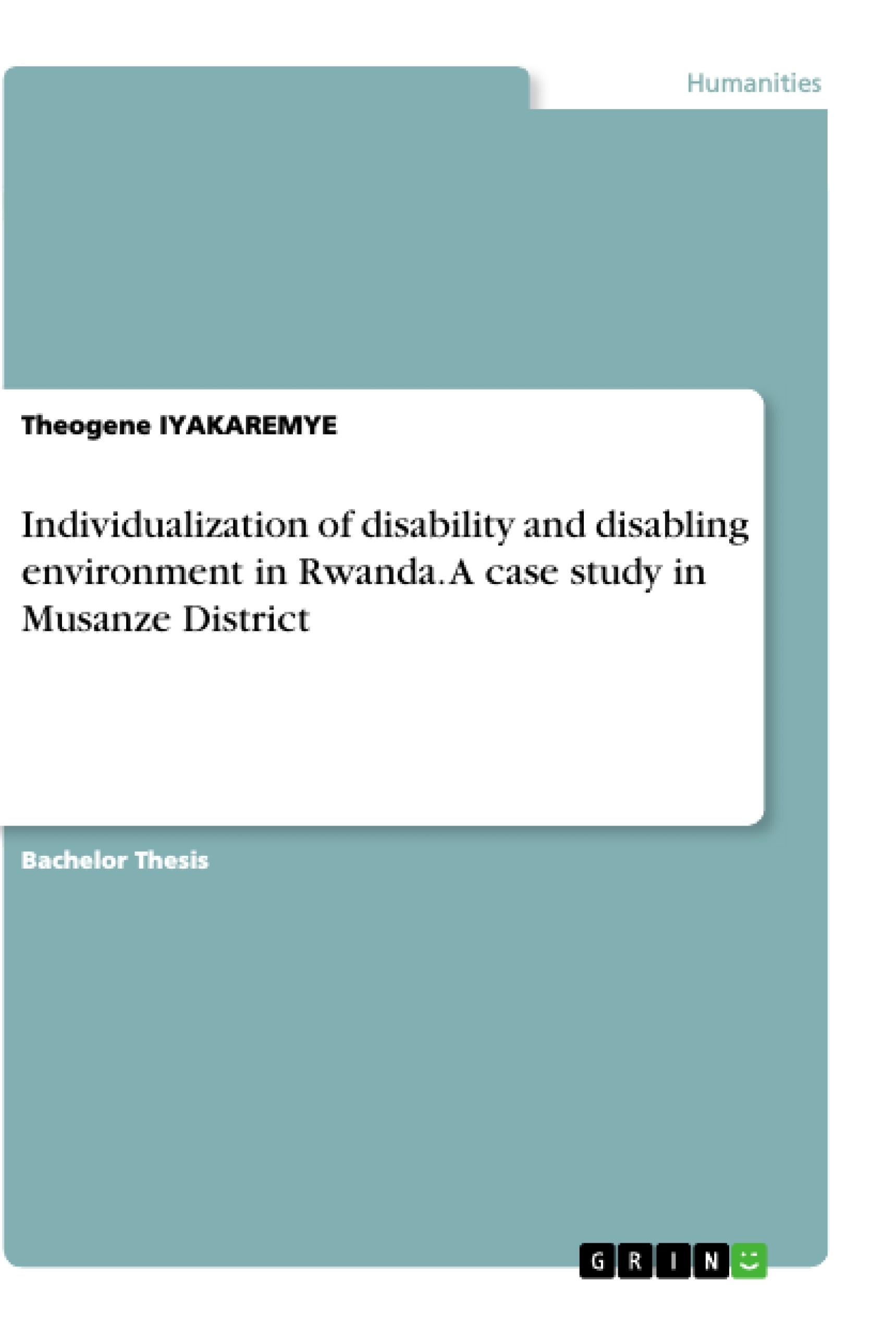This study has the general objective of investigating the current situation of keys barriers that affect the PWDs through their live experiences and challenges. The specifics objectives are: to investigate the current situation of contextual factors that affect PWDs based on day to day activities (their life experiences), residence housing conditions, the causes and types of their disabilities; to describe the socioeconomic characteristic of PWDs by their types of activity and income earned, ages, sex and marital status; to assess the level of Individualization of disability process against disabling environment in Muhoza Sector as well as the relationship between them and to identify the stakeholder, the programs or projects being involved in individualization process for enabling environment to PWDs. During our research, a cross sectional survey by questionnaire and the method of field observation, reports exploitation were used. The study took into consideration of 112 respondents of whom 109 were population with disability and 3 were local leaders in charge with disability (one at District level and two at Cell level of Mpenge and Ruhengeri) who live in Muhoza Sector in Musanze District.
The results of the study indicated that all 112 respondents equal to 100% of the respondents agreed that they have difficult of disability; they face with the various barriers as cited along this study. All concerned respondents said that the appreciation level of individualization of disability against disabling environment takes positive way even if it is at low level. The study concludes that there is a significant role of individualization of disability on enabling adequate environment for PWDs in Rwanda, using Muhoza administrative sector of Musanze District as a case study. Accordingly, all objectives of this study were achieved and all hypotheses were verified and confirmed. At the end of this study, there are different suggestions to the concerned people like Musanze District staff which should prepare the individualized solution toward disabling environment especially Muhoza sector and population with disability should be aware for their rights to better campaign and advocate themselves.
Inhaltsverzeichnis (Table of Contents)
- DEDICATION
- ACKNWOLDGMENTS
- LIST OF TABLES
- LIST OF FIGURES
- CHAPTER ONE: INTRODUCTION
- 1.1 Background of the study
- 1.2 Problem statement
- 1.3 Objectives of the study
- 1.3.1 General objective
- 1.3.2 Specific objectives
- 1.4 Research questions
- 1.5 Significance of the study
- 1.6 Scope of the study
- 1.7 Limitations of the study
- 1.8 Organization of the study
- CHAPTER TWO: LITERATURE REVIEW
- 2.1 Theoretical Framework
- 2.2 Conceptual Framework
- 2.3 The Disability and Disabling Environment
- 2.4 Individualization of Disability
- 2.5 The role of Stakeholders in addressing Disabling Environment
- CHAPTER THREE: METHODOLOGY
- 3.1 Research design
- 3.2 Study area
- 3.3 Population and sample size
- 3.4 Sampling Techniques
- 3.5 Data collection methods
- 3.5.1 Primary data
- 3.5.2 Secondary data
- 3.6 Data Analysis
- CHAPTER FOUR: PRESENTATION AND ANALYSIS OF DATA
- 4.1 Socio-demographic characteristics of respondents
- 4.2 Individualization of disability and the disabling environment
- 4.3 Stakeholders involvement in disability issues
- 4.4 Barriers faced by PWDs in Muhoza sector
- 4.5 Public services in Muhoza sector
- CHAPTER FIVE: DISCUSSION, CONCLUSION AND RECOMMENDATION
- 5.1 Discussion
- 5.2 Conclusion
- 5.3 Recommendations
Zielsetzung und Themenschwerpunkte (Objectives and Key Themes)
This study aims to investigate the individualization of disability and the disabling environment in Rwanda, with a specific focus on Muhoza sector in Musanze District. The research explores the experiences of individuals with disabilities and examines the role of stakeholders in addressing the challenges they face.
- Individualization of disability and its implications for individuals and society
- The nature and impact of the disabling environment in Rwanda
- The role of stakeholders in addressing disability issues
- The barriers faced by people with disabilities in accessing services and opportunities
- The potential for improving the lives of individuals with disabilities through policy and practice changes
Zusammenfassung der Kapitel (Chapter Summaries)
- Chapter One: Introduction provides a comprehensive overview of the study, outlining its background, problem statement, objectives, research questions, significance, scope, limitations, and organization. It sets the stage for the subsequent chapters by introducing the core concepts and contextualizing the study within the broader landscape of disability and development in Rwanda.
- Chapter Two: Literature Review presents a theoretical and conceptual framework for the study, drawing on existing research and literature to define key terms and concepts. It explores the relationship between disability and the disabling environment, examines different perspectives on individualization of disability, and discusses the roles and responsibilities of various stakeholders in addressing disability issues.
- Chapter Three: Methodology details the research design, study area, population and sample size, sampling techniques, data collection methods, and data analysis procedures employed in the study. It provides a transparent and rigorous account of the research methods used to gather and analyze data, ensuring the reliability and validity of the findings.
- Chapter Four: Presentation and Analysis of Data presents and analyzes the collected data, exploring the socio-demographic characteristics of the respondents, the relationship between individualization of disability and the disabling environment, the involvement of stakeholders in disability issues, the barriers faced by individuals with disabilities, and the public services available in the study area.
Schlüsselwörter (Keywords)
This study explores the key concepts of individualization of disability, disabling environment, stakeholder involvement, barriers faced by people with disabilities, public services, and the lived experiences of individuals with disabilities in Rwanda. These themes are interwoven throughout the study, providing insights into the complex challenges and opportunities associated with disability in the Rwandan context.
- Quote paper
- Theogene IYAKAREMYE (Author), 2019, Individualization of disability and disabling environment in Rwanda. A case study in Musanze District, Munich, GRIN Verlag, https://www.grin.com/document/490779




